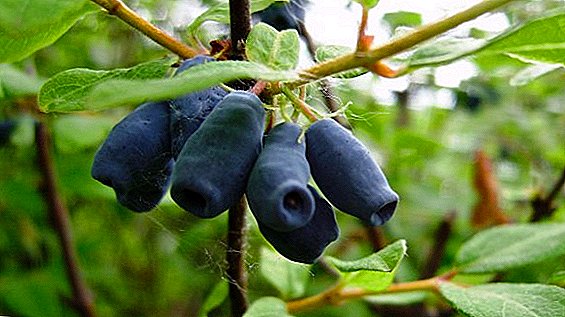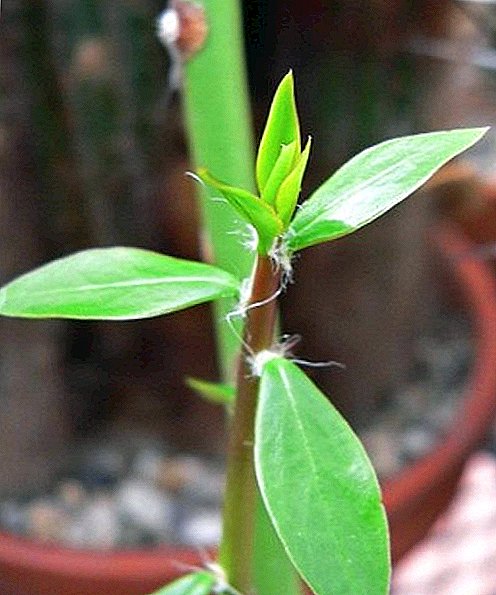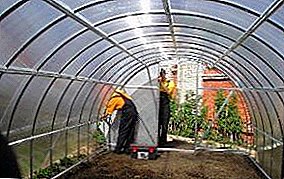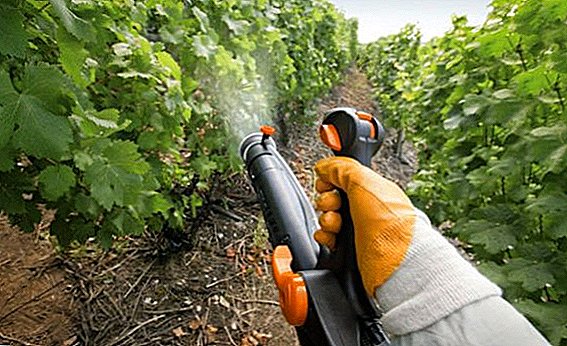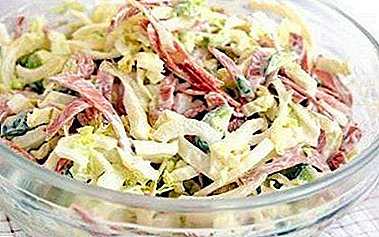 View floribunda "Leonardo da Vinci" got its name for a reason. The flower combines historical beauty and modern chic. With his presence, he is able to decorate any personal plot, and thanks to his unpretentious care, he became a favorite with many gardeners. Let us consider in more detail the features of the cultivation and care of flowers, "Leonardo da Vinci."
View floribunda "Leonardo da Vinci" got its name for a reason. The flower combines historical beauty and modern chic. With his presence, he is able to decorate any personal plot, and thanks to his unpretentious care, he became a favorite with many gardeners. Let us consider in more detail the features of the cultivation and care of flowers, "Leonardo da Vinci."
Description
The variety appeared in 1993 and quickly gained popularity flower growers from around the world. Bushes of this type are straight, densely growing, on average reach a height of 70-110 cm. Leaves are dark green in color, abundant, of a leathery structure. Flower buds thick, double, rich pink color, up to 10 cm in diameter.
In one brush can be 5-6 flowers. The aroma of flowers is light and persistent. "Leonardo da Vinci" blooms for quite a long time, until the first frost. The plant loves light, is not afraid of heavy rain and drought.
Did you know? The oldest rose in the world is about 1000 years old, it winds along the wall of the cathedral in the German city of Hildesheim.

Also, the positive characteristics of floribunda include:
- resistant color of the petals;
- unpretentious care;
- high resistance to basic flower diseases and pests;
- frost resistance.
Features of growing
Rosa "Leonardo da Vinci" can be grown both in open ground and at home. Open root roses are planted in March-April or August-November.
You will probably be interested to read about the varieties and the cultivation of Dutch, Canadian and English roses.
For a soil planting it is important to choose the right place and prepare the ground. To do this, the earth from the holes is mixed with peat, sand and humus (proportion 1: 2: 1) and bone meal with superphosphate is added. Thanks to this combination, seedlings root much faster, and the buds bloom earlier.
In the event that a heavy, dense ground is selected on the plot chosen for planting, drainage is done in it. It contributes to the removal of excess moisture, and also improves the oxygen supply. The pit is made deeper by 20 cm and a layer of expanded clay is poured at its bottom. 
Next, landing takes place according to this scheme:
- Pruned seedlings (dead roots are removed, live shortened by 2-3 cm, the stems are cut to a length of 20 cm, while leaving 3-4 leaves).
- Seedlings immersed in water for half an hour before planting.
- Dig a hole with a diameter of 50 cm and a depth of 10 cm more than the root system.
- 12-15 liters of water are poured into the prepared well.
- The rose is lowered into the hole, covered with earth and well tamped (you need to follow the root node, which must be above the surface).
We advise you to read how to grow a rose from a bouquet, how to preserve roses in a vase for a long time, how to plant rose seedlings from a box, and what mistakes gardeners make most mistakes when growing roses.
Near the planted bush is recommended to make an earth layer that will hold moisture. Also, the site should be closed from strong gusts of wind, especially on the north side, and surface water.
Video: features of planting roses
Important! If the place for planting is bright in direct sunlight, then for the first 2-3 weeks young plants need to create a reflective screen that will diffuse the light and create a shadow.
"Leonardo da Vinci" is great for breeding at home.
In order to get a good result, you should follow these landing rules:
- choose a bright place on the southern windowsill or on the terrace with good air circulation;
- take into account the fact that roses need constant watering, and overflow is harmful;
- ensure proper drainage;
- constantly loosen the ground around the seedlings;
- regularly feed the plant once a week;
- periodically remove dried flowers and leaves.

In winter, after the active flowering is complete, it is enough to put the home rose away from the batteries. To ensure the plant sunlight in the winter using special fitolampy. If you follow these recommendations, the rose will survive the winter without any problems and quickly come to life in the spring.
We recommend reading about the benefits of roses for human health, as well as how to dry roses and what can be done with them.
Care
Care for floribunda is simple, however, we will mention how to water and than to fertilize a plant, how to properly trim a bush and form a crown, as well as how to prepare a rose for wintering. In irrigation, you must adhere to the fact that the soil should always be wet. As soon as the soil dries up - this is a direct signal to watering.
Important! You can not water the plant during the day in the heat. When watering, water is poured under a bush, avoiding contact with leaves and flowers.
If the rose is periodically fed with fertilizers, it will bloom faster, give more buds and have a richer color and aroma. It is best to use ready-made mixtures for roses with a high content of potassium, nitrate and urea for this purpose.  From organic fertilizers, preference is given to compost and humus. To achieve a greater effect, it is recommended to alternate mineral fertilizers with organic matter. Top dressing should be carried out once a week before watering.
From organic fertilizers, preference is given to compost and humus. To achieve a greater effect, it is recommended to alternate mineral fertilizers with organic matter. Top dressing should be carried out once a week before watering.
Check out the rose and spring care features.
In order to form a beautiful crown, it must be cut off. This can be done in the spring, during the period of active growth. Circumcision is carried out moderately, leaving up to 6 buds, which is enough for the emergence of new shoots. With moderate pruning, the rose grows faster and blooms longer.
Despite the fact that "Leonardo da Vinci" is a fairly frost-resistant variety, it is better to prepare it for wintering, especially young cuttings. They warm the plants in the middle of autumn, when their activity decreases. All the leaves are removed from the roses, and the shoots are pruned to 35 cm.
Video: pruning and sheltering roses for the winter
The soil around seedlings abundantly sprinkled with tree bark, sawdust or dry peat. From above flowers are covered with plastic wrap. Thus, by the spring the plant will fully retain all its qualities.
Ground-covering, climbing and standard roses will beautifully decorate the space.
Diseases
This variety of floribunda is considered one of the most resistant to external pests. However, on his sheets may appear harmful bugs, so it is very important to periodically inspect the plant for extraneous fauna.
Among the main diseases and pests are the following:
- powdery mildew. It affects the leaves, shoots, flowers. The disease is activated in wet weather, after rains. White bloom covers the entire surface of the plant, after which the process of photosynthesis is disturbed and dying occurs. To get rid of this disease, remove all the affected parts from the bush and spray it with copper-soap solution or copper sulfate solution;

- black spot. This disease can manifest itself in the summer if the plant is deficient in potassium. Brown spots cover the outer surface of the leaves, after which they turn yellow and eventually fall off. Spraying Bordeaux liquid or solution "Fundazola" will help to cope with this problem;

Did you know? The largest rose bush is located in Arizona, it occupies an area equal in size to a football field. And more than 200 thousand white flowers bloom on it.
- spider mite The pest is activated in dry weather. From the inside of the leaves, he weaves a web and spoils the plant. For tick control, direct-acting insecticides are used. Shrubs are processed three times with a week break;

- rose aphid Under the harmful effects of this insect enters the whole plant, from the leaves to the buds. The parasite drinks the juice from the rose, thereby weakening it. To destroy a pest, a bush is sprayed with insecticides (Aktara, Aktellik, Fufanon) 3 times every three days. Before the procedure, the bush should be washed with running water.
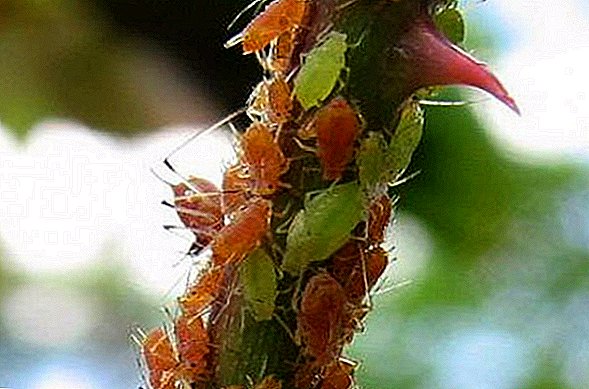
To reduce the risk of infecting roses, they are recommended to be planted next to plants such as lavender, calendula, marigolds - they scare off parasites. And if you plant garlic near a rose, it will save it from fungal diseases.
Breeding methods
Experienced gardeners consider the best option for breeding roses "Leonardo da Vinci" grafting, as a result of which the possibility of obtaining high-quality healthy plants is much higher.
For planting bushes using cuttings should follow the following sequence of actions:
- Choose sprigs not less than 5 mm thick.
- The material is cut into pieces of 8-10 cm, each of which should contain 2-3 buds.
- Cuttings carefully inspect for the presence of disease.
- The prepared parts of the plant are filled for half an hour with a phytohormonal solution that protects against parasites.
- In the previously prepared pits with a depth of 12-14 cm, cuttings are planted.
- Cover the plants with a greenhouse (frame with plastic wrap).
- Future bushes provide timely watering, airing and loosening the land.
Video: rose reproduction using cuttings
With a proper cutting procedure and regular care, the plants form a powerful root system and beautiful, healthy flowers. Rose "Leonardo da Vinci" is a very successful universal variety that requires a minimum of labor costs and time to care.
It is less sensitive to infestation by parasites, it quickly takes root in new places, it is highly frost resistant. Therefore, such floribunda would be an excellent option, both for novice gardeners and for professionals in their field.






